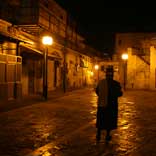Reflections
The Meah Shearim Neighborhood
The Meah Shearim neighborhood is one of the most ancient neighborhoods in Jerusalem outside the walls of the Old City and serves as a symbol of Torah observance without compromises even in today's modern world.
The Meah Shearim neighborhood was founded by the 'Chevrat Bonei Yerushalayim' group, led by Rabbi Yosef Rivlin who acquired the necessary experience while erecting the 'Nachalat Shivah' and the Beit David' neighborhoods. Other members of the one hundred and fifty member organization were Rabbi Ben Zion Lion and Rabbi Shmuel Humminer, who was the very first resident of the neighborhood. One of the streets in the neighborhood today bears his name.
Most of the members were poor and were supported by the various Kollelim of Jerusalem, which prevented them from purchasing land in the vicinity of the Old City as all lands surrounding the Old City were extremely expensive. For that reason, the members of the group decided to purchase a parcel of land called 'Kerem Kadchud' which was located approximately three kilometers from the walls of the city. 'Kerem Kadchud' was a 32 ½ dunam lot and was purchased in three phases from the Arabs of the Lifta village.
The group gathered for the planning of the neighborhood during the week when the Torah portion was parashat Toldot, from where the members of the group were inspired to name their new neighborhood. A verse in Toldot says: "And Yitzchak planted in the land and found one hundred gates (meah shearim) during that year, and he blessed G-d." The meeting took place in the Old City and was directed by Rabbi Shmuel Salant, who was also the Rabbi of Jerusalem, and Rabbi Meir Auerbach. In the meeting, the unique style of the future neighborhood was discussed, and many speeches encouraging the construction of the neighborhood in light of the density of the Old City were delivered.
The neighborhood infrastructure was planned by German architect Conrad Schick. For security reasons and due to the neighborhood's remoteness, the architect planned the structure of the neighborhood in a square-like fashion, with the buildings attached to each other so that they formed a protective wall around itself. Along the length of the wall, six wooden gates, which were to be closed each night and reopened in the morning, were erected. After a few years, the wooden gates were replaced by iron ones. A large courtyard was added in the center of the neighborhood, where deep pits were dug to collect the rainwater. Additionally, a large oven for bread baking, which was to be shared by all the residents, was built in the courtyard, as were a few shops. Aside from the physical requirements of the neighborhood, the spiritual needs of the future residents were also taken into account, hence a mikveh and a large synagogue named 'Yeshuoth Ya'akov' were established in the center of the courtyard. A Talmud Torah named 'Beit Avraham' was later added.
Approximately six months after the meeting of the group members – in the month of Iyar, 5634 – the cornerstone of the neighborhood was laid and less than a year later, during Hanukkah of 5635, the first ten buildings of the new neighborhood were already standing. In 5641, an inauguration ceremony was celebrated in the new neighborhood during which the apartments were divided by raffle between the group members. The last portion of the wall was then built. The apartments which were completed were allocated the first hundred members of the group, and for the members who joined the group later on, additional apartments were built after the neighborhood was already populated. During the building of these apartments, the original architectural plans were ignored and many crowded buildings were built on the open space of the courtyard. Within fifteen years of the neighborhood's establishment, close to two-hundred housing units were built with eight hundred residents. Following another three years, an additional one hundred units were added, and the number of residents almost doubled.
A special committee was appointed to oversee the physical and spiritual issues in the neighborhood. The committee numbered seven members and among the regulations determined by the members non-religious individuals were prohibited from settling in the neighborhood.
Due to the unbearable crowdedness in Meah Shearim, additional neighborhoods were built around it. These neighborhoods, which include 'Batei Ungarin' and 'Batei Warsaw', are today an integral part of Meah Shearim and share the same unique style.
Following the War of Independence, Jerusalem was divided in half, with the eastern part belonging to Jordan and the western part governed by the State of Israel. The Jordanian border was in extreme close proximity with the Meah Shearim neighborhood, a fact which prompted the Israeli authorities to erect a tall fence across the eastern side of the neighborhood so as to protect its residents from sniper fire.
Today, after the annexation of Eastern Jerusalem and the Old City to the State of Israel, the Meah Shearim neighborhood is located in the center of Jerusalem. Most of the original apartments are preserved and others were added either above the existing apartments or on vacant lots. The neighborhood's distinctive style evokes memories from a by-gone area and resembles the Jewish 'shtetl' of pre-war Europe. The residents are mostly religious Jews who belong to various Chassidic courts such as 'Toldos Aharon', 'Toldos Avraham Yitzchak', 'Breslov' or 'Karlin'.
The neighborhood residents were wrongly labeled extremist and primitive by the media due to the many violent demonstrations which they held in the Kikar HaShabbat square. The truth is, however, that the neighborhood residents are extraordinarily generous and display great hospitality to anyone whom they might encounter.
Due to the uniqueness of the neighborhood, it has become a popular tourist attraction for tourists all over the world. Large signs which request the visitors to adhere to the rules of modesty welcome the tourists at the entrance to the neighborhood.







